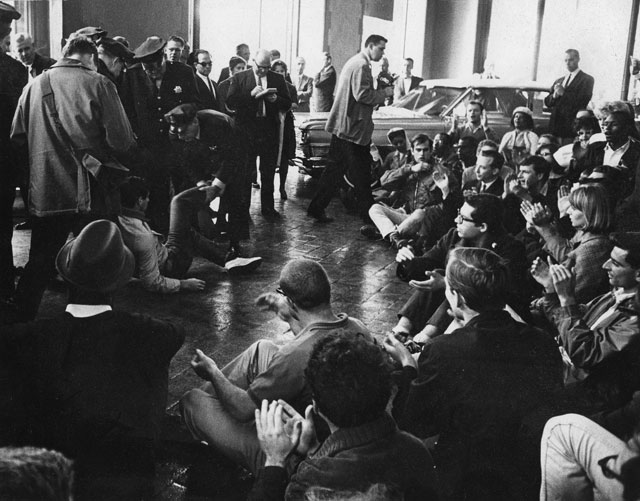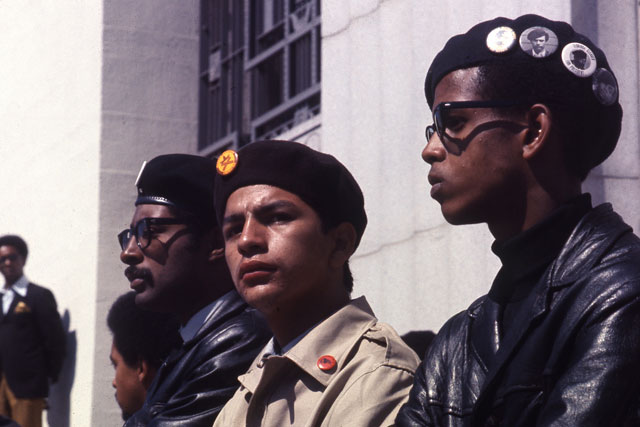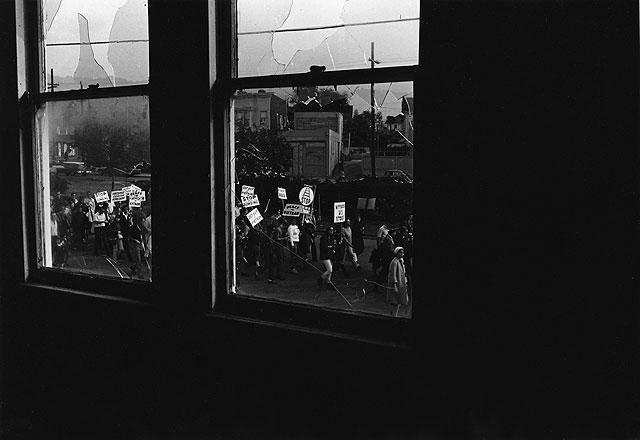“Look at this guy wearing white bucks! He’s got white bucks on and the cops are dragging him away by the leg” exclaims Stephen Ehret, chuckling to himself as he clicks on a photograph of a 1964 San Francisco sit-in. “That’s a great picture. We need to get that up on the website,” Ehret observes.
Jeffrey Blankfort, whose photograph we have been discussing, turns to me and says, “See? This is what happens; there are too many photographs to choose from.”

We’re sitting in Ehret’s Sausalito art studio among large-scale paintings of California landscapes. Ehret uploads scanned images to his friend’s online portfolio, which went live for the first time this year in honor of Blankfort’s 80th birthday.
As Ehret clicks, Blankfort regales me with stories of his photographic adventures, “You’ve got to tell me when to stop, I could go on forever,” Blankfort laughs.
In the early 1960s, “before anybody had long hair,” Blankfort got his start as a photojournalist by documenting San Francisco sit-ins. These NAACP demonstrations, like the one the buck-clad protester attended at the former Cadillac Agency on Van Ness, were a part of a critical effort to end racist hiring practices in the city, not only at car dealerships but also at hotels and restaurants.
“There are kids that go to school in the city and don’t know anything about the sit-ins. It’s a crime,” says Blankfort. This outrage drives Blankfort to share his photographs with the next generation to fill in the gaps in what he calls “sanitized history.”
Since the beginning of his career, Blankfort’s photographs have been shown in galleries and published in periodicals, books and retrospectives around the world. After getting his teaching credential later in life, Blankfort discovered his photographs could take on new significance in the classroom.
At Richmond High School, Blankfort’s pictures of the Black Panthers and the Brown Berets bridged the gap between history and modern struggles for many of his African-American and Latino students.

Blankfort says, “The black students did not want to hear about Martin Luther King, but when I talked to them about the Black Panthers, some of them had family in the Panthers, and suddenly they wanted to listen. And the attitude of the class changed so much when I would bring my photographs in. They didn’t relate to the South, they related to what went on in the Bay Area.”
For the past three years, Blankfort has worked with artist Stephen Ehret and educator Caitlin Hoffman to organize his countless photographs into a digital portfolio. The next step is to create more educational presentations that Blankfort can take to local campuses where students can benefit from his historical knowledge and first-hand accounts.
“Every student should know that until 1964 the Bay Area was just as racist as the South,” says Blankfort. Even today, Blankfort believes the Bay Area still has a long way to go towards attaining true equality.
Born in 1934, Blankfort feels lucky to have grown up in a progressive household during a troubled era. His father worked as a screenwriter in Hollywood and produced the first African-American musical, Jump for Joy, starring Duke Ellington. He ended up blacklisted and struggled to support his family without compromising his politics. Blankfort says, “My father was a very principled person, as was my mother and I got a lot inspiration from them. They taught me not to keep a set of double books in life. If you have parents like that you know you can’t sell out.”
Identifying as an independent leftist, Blankfort puts his politics before his career, although they often intersect. Arrested five times — but never convicted — Blankfort was on a first name basis with some local police. Attending protests equipped with a helmet, a gas mask and his camera, Blankfort quickly learned how to pre-focus his camera so he could be ready at a moment’s notice. More than a few of his photographs were used to absolve the wrongfully accused or to provide restitution for the abused.
In many cases, there would be no historical record of these events if Blankfort had not been there with his camera. “Today everyone has a cell phone camera, but there weren’t as many photographers at the time,” he says.
After traveling to Europe, Africa and the Middle East, Blankfort maintains that it is San Francisco in the early ’60s that truly stole his heart — and for keeps. He remembers the exact moment when he realized he had to live in San Francisco: It was while walking to the waterfront from Telegraph Hill when he discovered someone playing bagpipes in their car at two o’clock in the morning.

In fact if it weren’t for San Francisco, Blankfort believes he never could have become a professional photographer. Thanks to what is now known as the Harvey Milk Photography Center, Blankfort was able to learn how to use a darkroom through observation and trial and error. In the early ’60s the scene in Sausalito was the center of his artistic career and the Bay Area remains his home base. He still recognizes familiar faces while grabbing a bite to eat at what used to be one of his favorite coffee houses, and greets another local, Arthur Sheradan, with a fist bump. Blankfort explains, “He was one of the leaders of the 1965 anti-war march from Berkeley to Oakland.”
But it’s the faces he no longer sees that remind Blankfort that many of his contemporaries are no longer with us. He recently attended the memorial for the influential Bay Area activist, Yuri Kochiyama, who held the dying Malcolm X in her arms. “I’ve led — I think — a very privileged life. I’ve been fortunate enough to have had all these experiences and met a lot of amazing people along the way — some famous and many not — and been in the right places at the right times,” Blankfort adds, “and I’m still here!”
Browse 30 different galleries of Blankfort’s photography now available on his website jeffblankfortphotography.com. You can also contact Blankfort from the site to inquire about educational presentations.